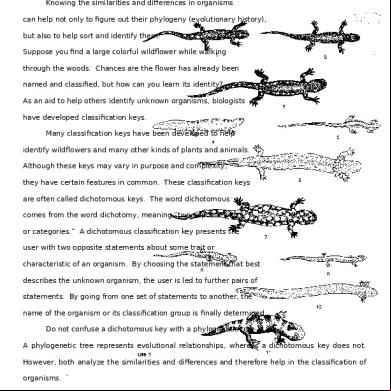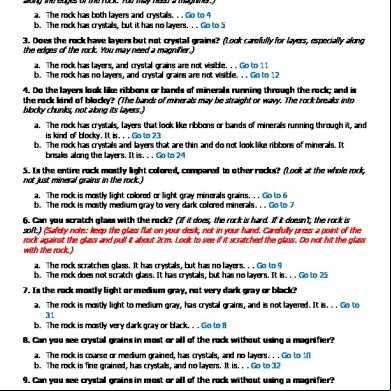Dichotomous Key Lizard 381w73
This document was ed by and they confirmed that they have the permission to share it. If you are author or own the copyright of this book, please report to us by using this report form. Report 2z6p3t
Overview 5o1f4z
& View Dichotomous Key Lizard as PDF for free.
More details 6z3438
- Words: 1,022
- Pages: 5
Name: Rane D. Date: ______________ Period: ____ Score: _______ Using and Constructing a Dichotomous Key – BACKGROUND Knowing the similarities and differences in organisms can help not only to figure out their phylogeny (evolutionary history), but also to help sort and identify them. Suppose you find a large colorful wildflower while walking through the woods. Chances are the flower has already been named and classified, but how can you learn its identity? As an aid to help others identify unknown organisms, biologists have developed classification keys. Many classification keys have been developed to help identify wildflowers and many other kinds of plants and animals. Although these keys may vary in purpose and complexity, they have certain features in common. These classification keys are often called dichotomous keys. The word dichotomous comes from the word dichotomy, meaning “two opposite parts or categories.” A dichotomous classification key presents the with two opposite statements about some trait or characteristic of an organism. By choosing the statement that best describes the unknown organism, the is led to further pairs of statements. By going from one set of statements to another, the name of the organism or its classification group is finally determined. Do not confuse a dichotomous key with a phylogenetic tree. A phylogenetic tree represents evolutional relationships, whereas a dichotomous key does not. However, both analyze the similarities and differences and therefore help in the classification of organisms. ` In this investigation, you will use a classification key to identify several salamanders (Part A). You will then write a classification key (Part B) for the Beasties you analyzed in Part 1. Page 1 of 5
Plethodon glutinosus, slimy salamander
Page 2 of 5
Name: Rane D.
Date: ______________ Period: ____ Score: _______
Using and Constructing a Dichotomous Key – DATA SHEET Part A: Using a Dichotomous Key Use the dichotomous key for salamanders to identify each of the 11 salamanders, writing both their scientific name and their common name. to write the scientific name in the correct format! Scientific Name 1. Plethodon glutinosus 2. Ambystoma jeffersonianum 3. Ambystoma maculatum 4. Triturus viridescens 5. Eurycea bislineata 6. Necturus maculosis 7. Ambystoma tigrinum 8. Hemidactylium scutatum 9. Plethodon cinereus 10. Siren intermedia 11. Ambystoma opacum
Common Name Slimy Salamander Jefferson Salamander Spotted Salamander Newt Two-Lined Salamander Mud puppy Tiger Salamander Four-toed Salamander Red-toed Salamander Siren Marbled Salamander
Part B: Constructing a Dichotomous Key 1. Use your data regarding the characteristics present/absent in Beasties below to construct your own dichotomous key. 2. that a dichotomous key includes pairs of opposing descriptions. At the end of the descriptions, the key should either identify the organism for you or lead you to another pair of opposing descriptions.
Page 3 of 5
1
2
3
4
5
6
7
8
Curly Tail
Go to 2
Split tail
Go to 7
Spots
Go to 5
No Spots
Go to 3
Sharp Teeth
Go to 4
No Sharp Teeth
Go to 5
Fin
Beastie F
No Fin
Go to 5
Tongue
Go to 6
No Tongue
Go to 8
Snake Tongue
Beastie E
Split Tongue
Beastie B
Dot Feet
Beastie A
Two-Toed
Beastie C
Big Eyes
Beastie D
Small Eyes
Outgroup
Conclusion Questions 1. As you used the classification key to identify the salamanders, did you go from general to specific characteristics or from specific to general characteristics? I went from general to specific characteristics. It started off broad, like the kind of tail and if it’s body had spots, and then it went to more descriptive characteristics like the kind of feet or the size of it’s eyes. 2. What two groupings (levels of classification) do the scientific names of the salamanders represent?
3. Was the classification key you constructed exactly like those of other students? Explain why or why not.
Page 4 of 5
My classification key was not like the other students’ keys. Some people had a different order in which to classify the differences of the Beasties, so they would even say “Go to…” a different number than mine. 4. If you were using actual living organisms, what other characteristics could you use to identify them? I could use all my senses to identify the organism rather than just sight. For example, the sound it makes or what it might feel like. Critical Thinking and Application Questions 1. Do you think that there may be some closely related species of organisms that cannot be identified with a classification key? Explain your answer. I think there may be some closely related organisms that cannot be identified by a classification key. Some may look exactly alike with only one minor difference that cannot be inputted into the key, or there could be something molecular that divides them but could not be seen by merely looking at it. 2. Why do you think biological classification keys always present two, rather than some other number, of choices at each step? No, I do not think biological classification keys always present two choices in each step. There may be other choices that fit in that category, so they would branch out and go towards another solution that the other ones didn’t have. 3. What types of problems would scientists have today if Carolus Linnaeus had not developed his classification and naming system of organisms? Scientists would probably get closely related organisms confused with one another, mixing up their research and halting their endeavors. Also, scientists would not know which organisms were related and which organisms weren’t. Some organisms or species could not have a name or means of identifying it. 4. Explain what is meant by the statement “Classification systems are the inventions of humans; diversity is the product of evolution.” The names of species and how we divide them is what humans decided to do to keep track of living things on this planet. The diversity of the actual species and organisms is made by evolution, and we merely follow and record it. One species can break off into two, and humans played no role in it, so they just record it for future use.
Page 5 of 5
Plethodon glutinosus, slimy salamander
Page 2 of 5
Name: Rane D.
Date: ______________ Period: ____ Score: _______
Using and Constructing a Dichotomous Key – DATA SHEET Part A: Using a Dichotomous Key Use the dichotomous key for salamanders to identify each of the 11 salamanders, writing both their scientific name and their common name. to write the scientific name in the correct format! Scientific Name 1. Plethodon glutinosus 2. Ambystoma jeffersonianum 3. Ambystoma maculatum 4. Triturus viridescens 5. Eurycea bislineata 6. Necturus maculosis 7. Ambystoma tigrinum 8. Hemidactylium scutatum 9. Plethodon cinereus 10. Siren intermedia 11. Ambystoma opacum
Common Name Slimy Salamander Jefferson Salamander Spotted Salamander Newt Two-Lined Salamander Mud puppy Tiger Salamander Four-toed Salamander Red-toed Salamander Siren Marbled Salamander
Part B: Constructing a Dichotomous Key 1. Use your data regarding the characteristics present/absent in Beasties below to construct your own dichotomous key. 2. that a dichotomous key includes pairs of opposing descriptions. At the end of the descriptions, the key should either identify the organism for you or lead you to another pair of opposing descriptions.
Page 3 of 5
1
2
3
4
5
6
7
8
Curly Tail
Go to 2
Split tail
Go to 7
Spots
Go to 5
No Spots
Go to 3
Sharp Teeth
Go to 4
No Sharp Teeth
Go to 5
Fin
Beastie F
No Fin
Go to 5
Tongue
Go to 6
No Tongue
Go to 8
Snake Tongue
Beastie E
Split Tongue
Beastie B
Dot Feet
Beastie A
Two-Toed
Beastie C
Big Eyes
Beastie D
Small Eyes
Outgroup
Conclusion Questions 1. As you used the classification key to identify the salamanders, did you go from general to specific characteristics or from specific to general characteristics? I went from general to specific characteristics. It started off broad, like the kind of tail and if it’s body had spots, and then it went to more descriptive characteristics like the kind of feet or the size of it’s eyes. 2. What two groupings (levels of classification) do the scientific names of the salamanders represent?
3. Was the classification key you constructed exactly like those of other students? Explain why or why not.
Page 4 of 5
My classification key was not like the other students’ keys. Some people had a different order in which to classify the differences of the Beasties, so they would even say “Go to…” a different number than mine. 4. If you were using actual living organisms, what other characteristics could you use to identify them? I could use all my senses to identify the organism rather than just sight. For example, the sound it makes or what it might feel like. Critical Thinking and Application Questions 1. Do you think that there may be some closely related species of organisms that cannot be identified with a classification key? Explain your answer. I think there may be some closely related organisms that cannot be identified by a classification key. Some may look exactly alike with only one minor difference that cannot be inputted into the key, or there could be something molecular that divides them but could not be seen by merely looking at it. 2. Why do you think biological classification keys always present two, rather than some other number, of choices at each step? No, I do not think biological classification keys always present two choices in each step. There may be other choices that fit in that category, so they would branch out and go towards another solution that the other ones didn’t have. 3. What types of problems would scientists have today if Carolus Linnaeus had not developed his classification and naming system of organisms? Scientists would probably get closely related organisms confused with one another, mixing up their research and halting their endeavors. Also, scientists would not know which organisms were related and which organisms weren’t. Some organisms or species could not have a name or means of identifying it. 4. Explain what is meant by the statement “Classification systems are the inventions of humans; diversity is the product of evolution.” The names of species and how we divide them is what humans decided to do to keep track of living things on this planet. The diversity of the actual species and organisms is made by evolution, and we merely follow and record it. One species can break off into two, and humans played no role in it, so they just record it for future use.
Page 5 of 5





